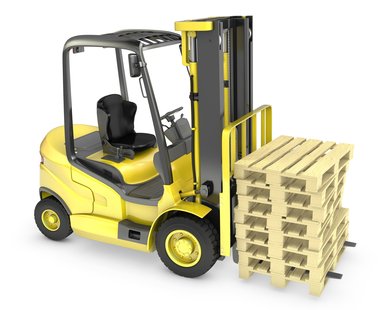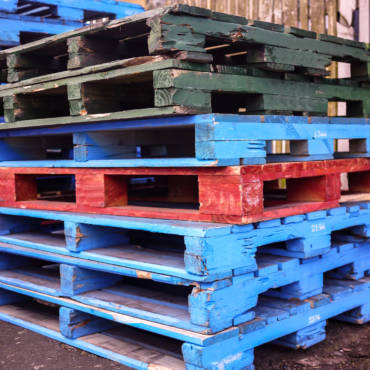If you are manually handling pallets, ensure that you are using good quality gloves to protect your hands from injury caused by wood splinters or nails. Be particularly careful with injuries caused by rusty nails. Rusty or not, an injury related to a puncture can be minimized when wearing appropriate gloves.
Avoid walking over pallets. If walking over a pallet becomes necessary or in areas where pallets are being handled, ensure that you are wearing proper protective footwear. The recommended safety foot wear (CSA Grade1) will bear a green triangle patch somewhere on the boot or shoe. This type of footwear protects you from a possible toe injuries or an injury that may be caused by sharp objects penetrating the sole of your foot. The CSA Grade 1 foot wear has a steel toe and a steel plate running the length of your foot sole.
Pallets may weigh anywhere from 30 to 90 pounds. If you are asked to manually move a pallet, or if you are required to hand stack pallets, exercise good posture. In order to prevent unnecessary back strains, bend your legs and keep your back straight. If done correctly, your legs should be doing most of the lifting.
As for the stacking of pallets, your company may have height restrictions. Make sure you are familiar with your company’s policy regarding locations and/or stacked pallet height. Your company’s Health & Safety team may have something to do with this. Ask prior to doing it so proper procedure is followed.
Your company will likely have a policy on the recycling of pallets. Ask your supervisor if the pallets are going to a wood chipper or to your local pallet recycler. Today a large number of damaged pallets are repaired by pallet recycling companies and in no time are back in service. Don’t mix wood and waste together; always think recycling?
 In most companies the most ideal and efficient way to move pallets is through the use of lift trucks. These vehicles have tremendous power and can easily destroy a wooden or plastic pallet. During the lifting procedure, make sure that when the forks that enter the pallet are properly aligned in order to prevent damage to the upper and lower lead boards.
In most companies the most ideal and efficient way to move pallets is through the use of lift trucks. These vehicles have tremendous power and can easily destroy a wooden or plastic pallet. During the lifting procedure, make sure that when the forks that enter the pallet are properly aligned in order to prevent damage to the upper and lower lead boards.
There are two ways you can easily damage a pallet using battery or propane powered vehicle. Dragging the pallet, or allowing a portion of the vehicle to impact the front of the pallet. Always bring your vehicle to a full stop before moving the pallet. The life of the pallet is in your hands.





